Attached files
| file | filename |
|---|---|
| 8-K - 8-K - Aeglea BioTherapeutics, Inc. | agle-8k_20210105.htm |
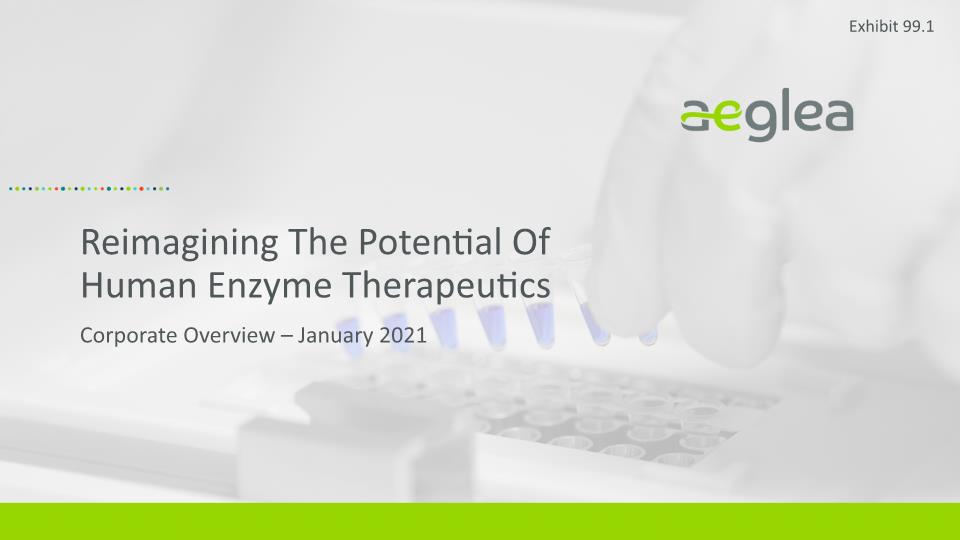
Reimagining The Potential Of Human Enzyme Therapeutics Corporate Overview – January 2021 Exhibit 99.1
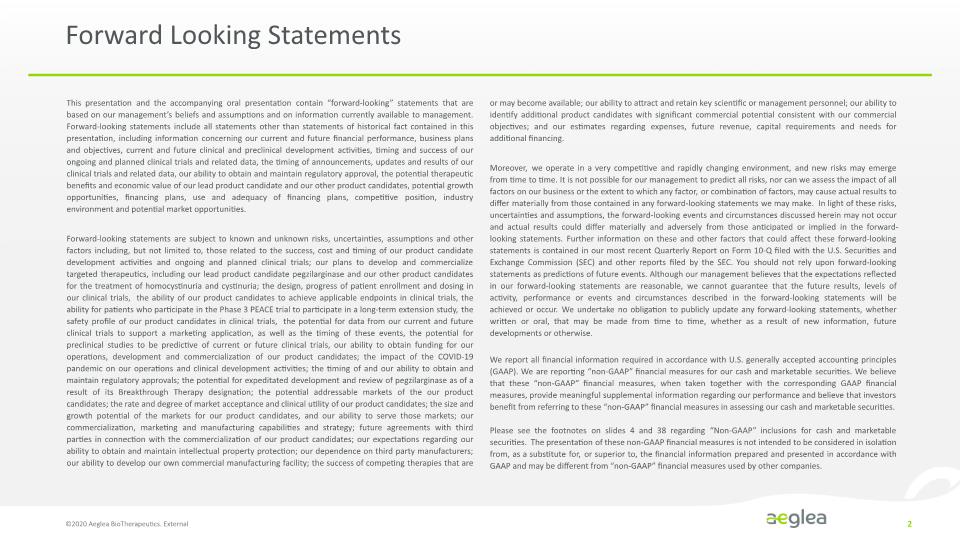
Forward Looking Statements ©2020 Aeglea BioTherapeutics. External 2 This presentation and the accompanying oral presentation contain “forward-looking” statements that are based on our management’s beliefs and assumptions and on information currently available to management. Forward-looking statements include all statements other than statements of historical fact contained in this presentation, including information concerning our current and future financial performance, business plans and objectives, current and future clinical and preclinical development activities, timing and success of our ongoing and planned clinical trials and related data, the timing of announcements, updates and results of our clinical trials and related data, our ability to obtain and maintain regulatory approval, the potential therapeutic benefits and economic value of our lead product candidate and our other product candidates, potential growth opportunities, financing plans, use and adequacy of financing plans, competitive position, industry environment and potential market opportunities. Forward-looking statements are subject to known and unknown risks, uncertainties, assumptions and other factors including, but not limited to, those related to the success, cost and timing of our product candidate development activities and ongoing and planned clinical trials; our plans to develop and commercialize targeted therapeutics, including our lead product candidate pegzilarginase and our other product candidates for the treatment of homocystinuria and cystinuria; the design, progress of patient enrollment and dosing in our clinical trials, the ability of our product candidates to achieve applicable endpoints in clinical trials, the ability for patients who participate in the Phase 3 PEACE trial to participate in a long-term extension study, the safety profile of our product candidates in clinical trials, the potential for data from our current and future clinical trials to support a marketing application, as well as the timing of these events, the potential for preclinical studies to be predictive of current or future clinical trials, our ability to obtain funding for our operations, development and commercialization of our product candidates; the impact of the COVID-19 pandemic on our operations and clinical development activities; the timing of and our ability to obtain and maintain regulatory approvals; the potential for expeditated development and review of pegzilarginase as of a result of its Breakthrough Therapy designation; the potential addressable markets of the our product candidates; the rate and degree of market acceptance and clinical utility of our product candidates; the size and growth potential of the markets for our product candidates, and our ability to serve those markets; our commercialization, marketing and manufacturing capabilities and strategy; future agreements with third parties in connection with the commercialization of our product candidates; our expectations regarding our ability to obtain and maintain intellectual property protection; our dependence on third party manufacturers; our ability to develop our own commercial manufacturing facility; the success of competing therapies that are or may become available; our ability to attract and retain key scientific or management personnel; our ability to identify additional product candidates with significant commercial potential consistent with our commercial objectives; and our estimates regarding expenses, future revenue, capital requirements and needs for additional financing. Moreover, we operate in a very competitive and rapidly changing environment, and new risks may emerge from time to time. It is not possible for our management to predict all risks, nor can we assess the impact of all factors on our business or the extent to which any factor, or combination of factors, may cause actual results to differ materially from those contained in any forward-looking statements we may make. In light of these risks, uncertainties and assumptions, the forward-looking events and circumstances discussed herein may not occur and actual results could differ materially and adversely from those anticipated or implied in the forward-looking statements. Further information on these and other factors that could affect these forward-looking statements is contained in our most recent Quarterly Report on Form 10-Q filed with the U.S. Securities and Exchange Commission (SEC) and other reports filed by the SEC. You should not rely upon forward-looking statements as predictions of future events. Although our management believes that the expectations reflected in our forward-looking statements are reasonable, we cannot guarantee that the future results, levels of activity, performance or events and circumstances described in the forward-looking statements will be achieved or occur. We undertake no obligation to publicly update any forward-looking statements, whether written or oral, that may be made from time to time, whether as a result of new information, future developments or otherwise. We report all financial information required in accordance with U.S. generally accepted accounting principles (GAAP). We are reporting “non-GAAP” financial measures for our cash and marketable securities. We believe that these “non-GAAP” financial measures, when taken together with the corresponding GAAP financial measures, provide meaningful supplemental information regarding our performance and believe that investors benefit from referring to these “non-GAAP” financial measures in assessing our cash and marketable securities. Please see the footnotes on slides 4 and 38 regarding “Non-GAAP” inclusions for cash and marketable securities. The presentation of these non-GAAP financial measures is not intended to be considered in isolation from, as a substitute for, or superior to, the financial information prepared and presented in accordance with GAAP and may be different from “non-GAAP” financial measures used by other companies.
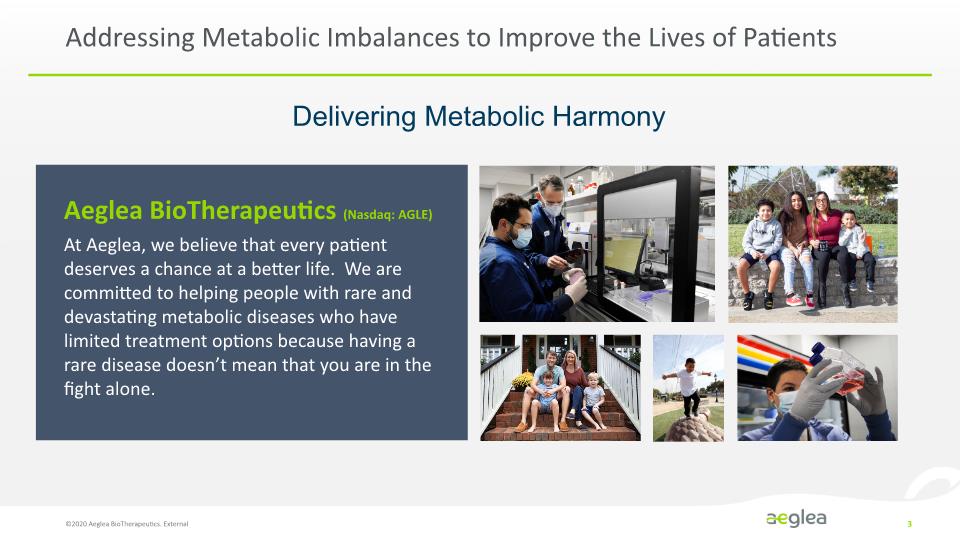
Addressing Metabolic Imbalances to Improve the Lives of Patients ©2020 Aeglea BioTherapeutics. External 3 Delivering Metabolic Harmony Aeglea BioTherapeutics (Nasdaq: AGLE) At Aeglea, we believe that every patient deserves a chance at a better life. We are committed to helping people with rare and devastating metabolic diseases who have limited treatment options because having a rare disease doesn’t mean that you are in the fight alone.

Unlocking the Potential of Human Enzymes to Deliver Life-Changing Solutions for People with Rare Metabolic Diseases ©2020 Aeglea BioTherapeutics. External 4 PEGZILARGINASE IN ARGINASE 1 DEFICIENCY AGLE-177 IN HOMOCYSTINURIA (Formerly called ACN00177) ENZYME THERAPEUTICS PLATFORM Enhanced human arginase that enzymatically lowers arginine levels PEACE – pivotal Phase 3 trial enrolling Novel recombinant human enzyme that enzymatically lowers homocysteine levels Phase 1/2 trial initiated Rare metabolic disease monogenic focus Most advanced program in Cystinuria “Non-GAAP” cash, cash equivalents and marketable securities as of September 30, 2020: $166.11 million (no debt) Expected funding runway: into 2023 1Includes $24.6M net proceeds from shares of common stock sold under our ATM program between October 1, 2020 and November 4, 2020 along with cash, cash equivalents, restricted cash and marketable securities of $141.5M as of September 30, 2020. This amount reflects Aeglea’s estimates based solely upon information available to it as of the date of the quarterly report, and the amount reported is not a comprehensive statement of its financial results or position as of September 30, 2020. Includes $1.5mm of restricted cash.
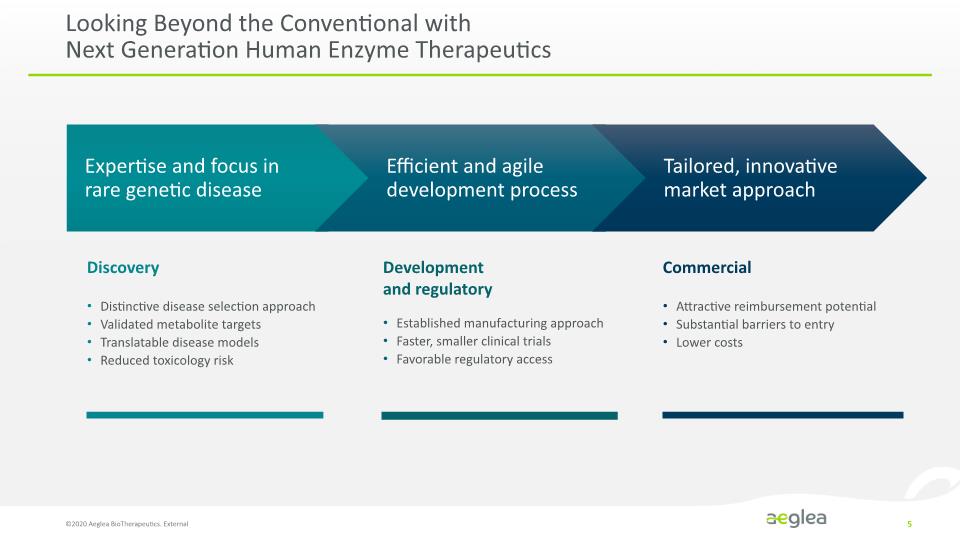
Looking Beyond the Conventional with Next Generation Human Enzyme Therapeutics ©2020 Aeglea BioTherapeutics. External 5 Distinctive disease selection approach Validated metabolite targets Translatable disease models Reduced toxicology risk Established manufacturing approach Faster, smaller clinical trials Favorable regulatory access Attractive reimbursement potential Substantial barriers to entry Lower costs Discovery Development and regulatory Commercial
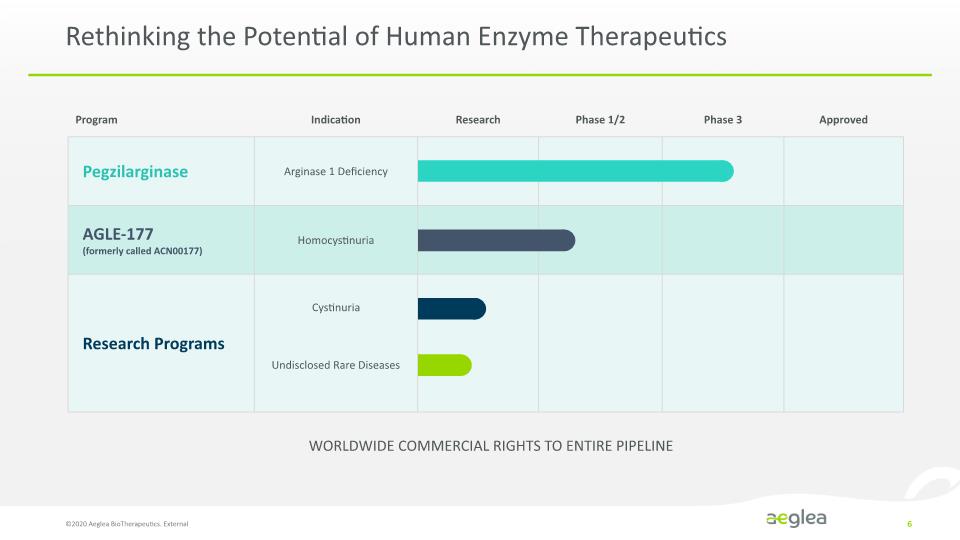
Rethinking the Potential of Human Enzyme Therapeutics ©2020 Aeglea BioTherapeutics. External 6 WORLDWIDE COMMERCIAL RIGHTS TO ENTIRE PIPELINE
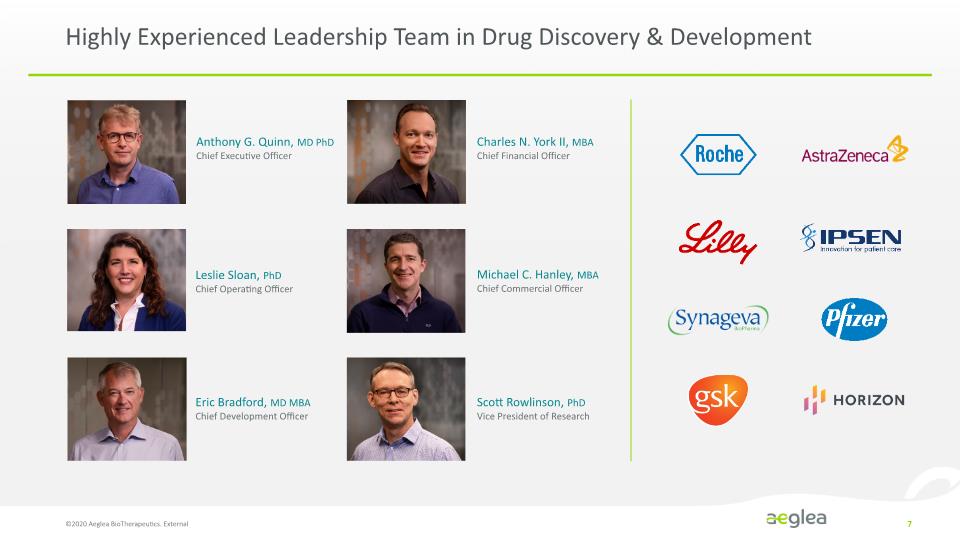
Highly Experienced Leadership Team in Drug Discovery & Development Anthony G. Quinn, MD PhD Chief Executive Officer Leslie Sloan, PhD Chief Operating Officer Charles N. York II, MBA Chief Financial Officer Scott Rowlinson, PhD Vice President of Research Michael C. Hanley, MBA Chief Commercial Officer Eric Bradford, MD MBA Chief Development Officer ©2020 Aeglea BioTherapeutics. External 7
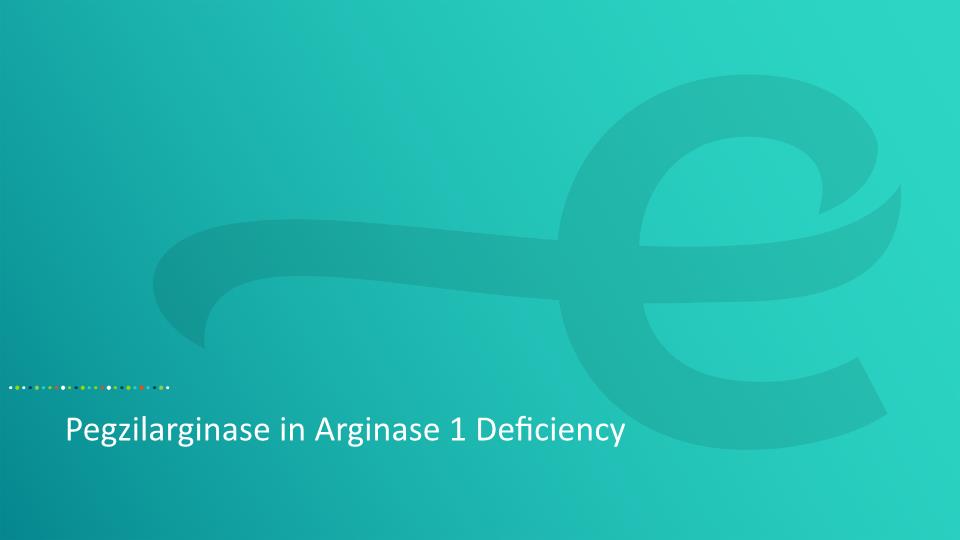
Pegzilarginase in Arginase 1 Deficiency
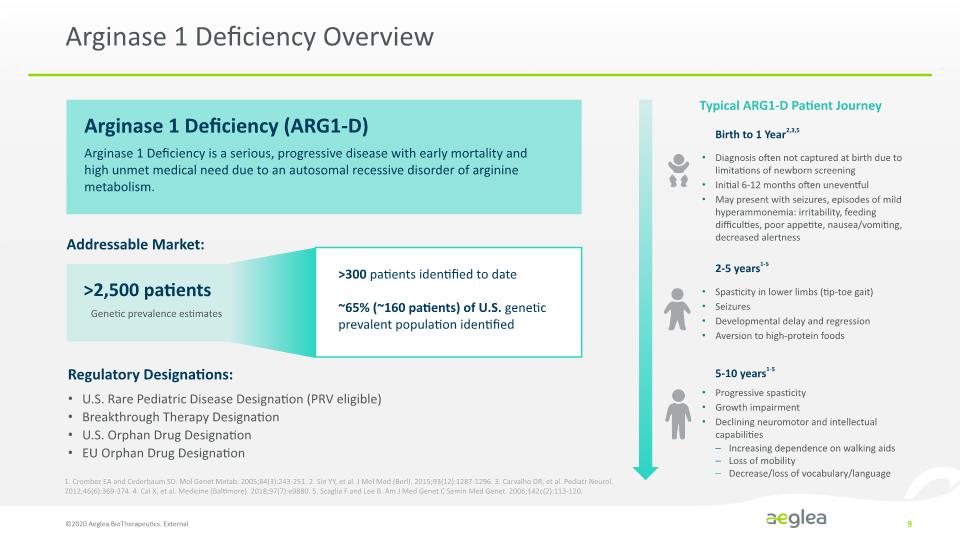
Arginase 1 Deficiency Overview ©2020 Aeglea BioTherapeutics. External 9 Arginase 1 Deficiency (ARG1-D) Arginase 1 Deficiency is a serious, progressive disease with early mortality and high unmet medical need due to an autosomal recessive disorder of arginine metabolism. Addressable Market: >2,500 patients Genetic prevalence estimates U.S. Rare Pediatric Disease Designation (PRV eligible) Breakthrough Therapy Designation U.S. Orphan Drug Designation EU Orphan Drug Designation Regulatory Designations: Typical ARG1-D Patient Journey Birth to 1 Year2,3,5 2-5 years1-5 5-10 years1-5 Diagnosis often not captured at birth due to limitations of newborn screening Initial 6-12 months often uneventful May present with seizures, episodes of mild hyperammonemia: irritability, feeding difficulties, poor appetite, nausea/vomiting, decreased alertness Spasticity in lower limbs (tip-toe gait) Seizures Developmental delay and regression Aversion to high-protein foods Progressive spasticity Growth impairment Declining neuromotor and intellectual capabilities Increasing dependence on walking aids Loss of mobility Decrease/loss of vocabulary/language >300 patients identified to date ~65% (~160 patients) of U.S. genetic prevalent population identified 1. Crombez EA and Cederbaum SD. Mol Genet Metab. 2005;84(3):243-251. 2. Sin YY, et al. J Mol Med (Berl). 2015;93(12):1287-1296. 3. Carvalho DR, et al. Pediatr Neurol. 2012;46(6):369-374. 4. Cai X, et al. Medicine (Baltimore). 2018;97(7):e9880. 5. Scaglia F and Lee B. Am J Med Genet C Semin Med Genet. 2006;142c(2):113-120.
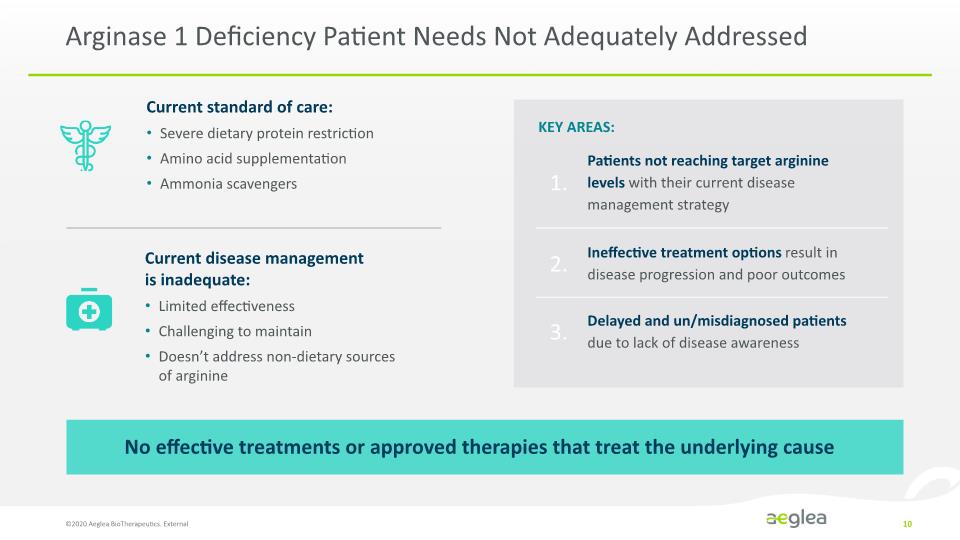
KEY AREAS: Arginase 1 Deficiency Patient Needs Not Adequately Addressed No effective treatments or approved therapies that treat the underlying cause ©2020 Aeglea BioTherapeutics. External 10 Current standard of care: Severe dietary protein restriction Amino acid supplementation Ammonia scavengers Current disease management is inadequate: Limited effectiveness Challenging to maintain Doesn’t address non-dietary sources of arginine Delayed and un/misdiagnosed patients due to lack of disease awareness Patients not reaching target arginine levels with their current disease management strategy Ineffective treatment options result in disease progression and poor outcomes 1. 2. 3.

1-Year Data from Phase 1/2 + Open-Label Extension Study of Pegzilarginase in Arginase 1 Deficiency Patients ©2020 Aeglea BioTherapeutics. External 11 Pegzilarginase was shown to have a favorable safety profile More than 750 doses administered in the Phase 1/2 clinical trial (101A) and Phase 2 OLE study (102A) Approximately 500 intravenous doses Most treatment-related adverse events were mild The frequency of treatment-related adverse events decreased over time Hypersensitivity and hyperammonemia were the most common treatment-related serious adverse events; expected and manageable *Values are median (range) unless stated otherwise. Arg, arginine; ARG1, arginase 1; BL, baseline; NH3, ammonia; 6MWT, 6-minute walk test; GMFM-D/E, Gross Motor Function Measure Part D/E; Pt, patient, ** 1 patient non-assessable (wheelchair bound) SAFETY SUMMARY

Pegzilarginase Markedly Reduces and Sustainably Controls Plasma Arginine ©2020 Aeglea BioTherapeutics. External 12 Plasma Arginine in Response to Pegzilarginase Baseline plasma arginine on standard disease management was markedly elevated Significant and sustained reduction in plasma arginine were achieved from baseline to week 1, week 8, week 20 and week 56 At the week 56 analysis: The median plasma arginine was 99µM 10/13 patients achieved plasma arginine within the normal range (40-115µM) 13/13 patients achieved plasma arginine within the target range (<200µM) *#’s are medians 56 WEEK ANALYSIS 389 171 127 112 99
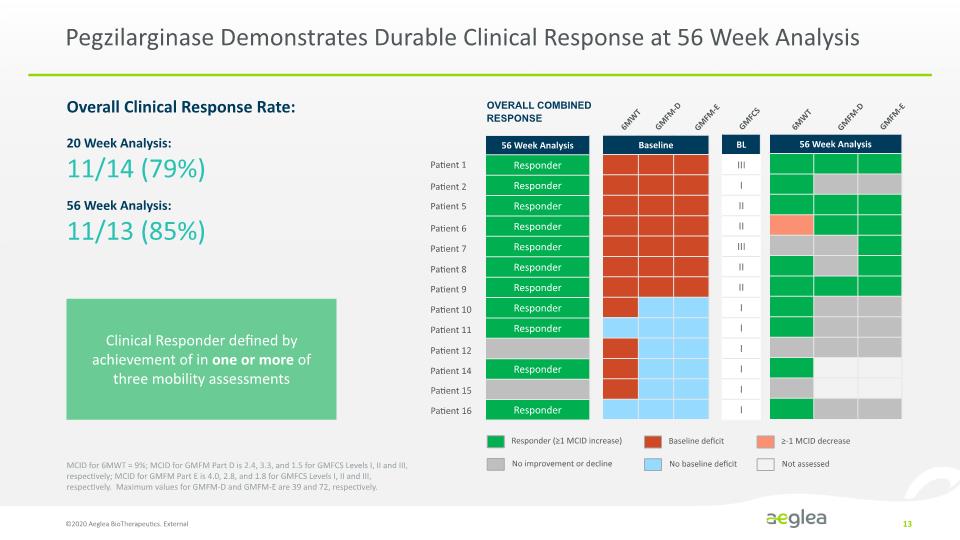
Clinical Responder defined by achievement of in one or more of three mobility assessments Pegzilarginase Demonstrates Durable Clinical Response at 56 Week Analysis ©2020 Aeglea BioTherapeutics. External 13 20 Week Analysis: 11/14 (79%) 56 Week Analysis: 11/13 (85%) MCID for 6MWT = 9%; MCID for GMFM Part D is 2.4, 3.3, and 1.5 for GMFCS Levels I, II and III, respectively; MCID for GMFM Part E is 4.0, 2.8, and 1.8 for GMFCS Levels I, II and III, respectively. Maximum values for GMFM-D and GMFM-E are 39 and 72, respectively. Overall Clinical Response Rate:
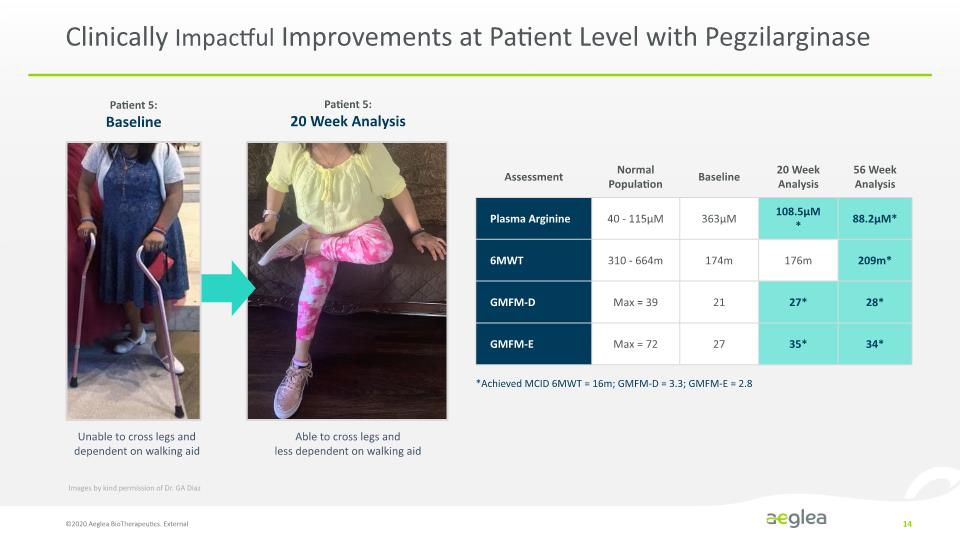
Clinically Impactful Improvements at Patient Level with Pegzilarginase ©2020 Aeglea BioTherapeutics. External 14 Patient 5: Baseline Patient 5: 20 Week Analysis Unable to cross legs and dependent on walking aid Able to cross legs and less dependent on walking aid *Achieved MCID 6MWT = 16m; GMFM-D = 3.3; GMFM-E = 2.8 Images by kind permission of Dr. GA Diaz
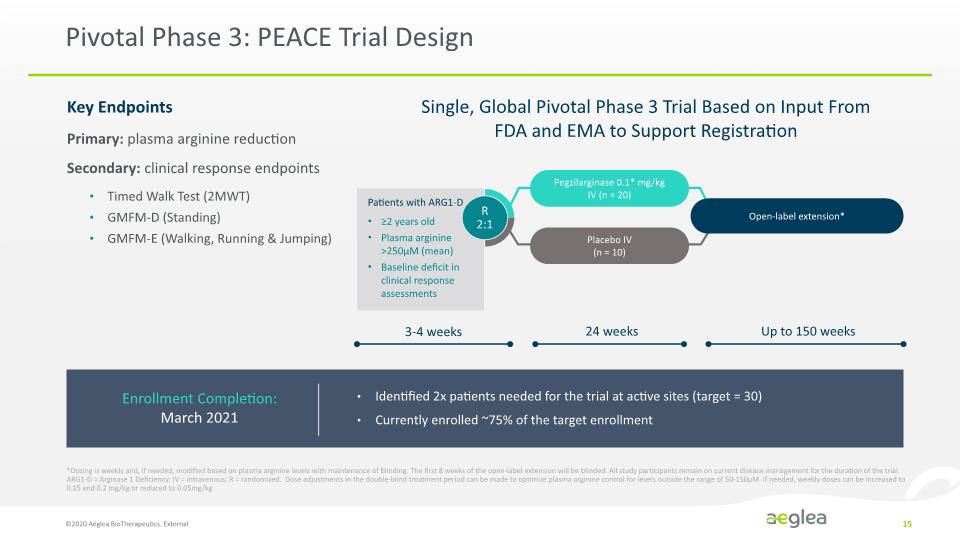
Pivotal Phase 3: PEACE Trial Design ©2020 Aeglea BioTherapeutics. External 15 Key Endpoints Primary: plasma arginine reduction Secondary: clinical response endpoints Timed Walk Test (2MWT) GMFM-D (Standing) GMFM-E (Walking, Running & Jumping) Single, Global Pivotal Phase 3 Trial Based on Input From FDA and EMA to Support Registration *Dosing is weekly and, if needed, modified based on plasma arginine levels with maintenance of blinding. The first 8 weeks of the open-label extension will be blinded. All study participants remain on current disease management for the duration of the trial. ARG1-D = Arginase 1 Deficiency; IV = intravenous; R = randomized. Dose adjustments in the double-blind treatment period can be made to optimize plasma arginine control for levels outside the range of 50-150µM. If needed, weekly doses can be increased to 0.15 and 0.2 mg/kg or reduced to 0.05mg/kg Enrollment Completion: March 2021 Identified 2x patients needed for the trial at active sites (target = 30) Currently enrolled ~75% of the target enrollment
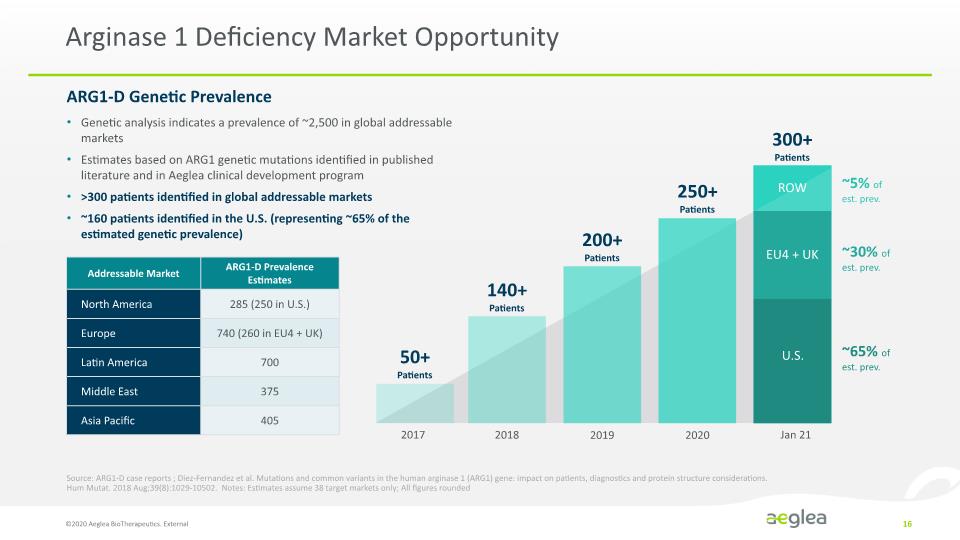
Arginase 1 Deficiency Market Opportunity ©2020 Aeglea BioTherapeutics. External 16 Genetic analysis indicates a prevalence of ~2,500 in global addressable markets Estimates based on ARG1 genetic mutations identified in published literature and in Aeglea clinical development program >300 patients identified in global addressable markets ~160 patients identified in the U.S. (representing ~65% of the estimated genetic prevalence) ARG1-D Genetic Prevalence Source: ARG1-D case reports ; Diez-Fernandez et al. Mutations and common variants in the human arginase 1 (ARG1) gene: impact on patients, diagnostics and protein structure considerations. Hum Mutat. 2018 Aug;39(8):1029-10502. Notes: Estimates assume 38 target markets only; All figures rounded 2017 2018 2019 2020 Jan 21 50+ Patients 140+ Patients 200+ Patients 250+ Patients 300+ Patients U.S. EU4 + UK ROW ~65% of est. prev. ~5% of est. prev. ~30% of est. prev.

Building a Commercial Organization to Serve the Future Patient Identification Scientific Communications Access & Reimbursement Worldwide commercial rights with ongoing ex-U.S. partnering discussions Strategic, senior commercial leadership team in place with relevant ultra-rare launch experience Plans to establish a focused and agile U.S. commercial organization Field-based medical, patient access and sales teams (~15-20 total FTEs) to educate and serve a highly targeted set of physician specialties Additional key functions including marketing, analytics, patient services, market access and public affairs Ability to leverage commercial infrastructure to benefit earlier-stage pipeline programs Commercial Planning Key Pillars ©2020 Aeglea BioTherapeutics. External 17

Arginase 1 Deficiency Key Highlights and Next Steps ©2020 Aeglea BioTherapeutics. External 18 Sustained control of plasma arginine 85% (11/13) of patients at the 56 week analysis were clinical responders Well tolerated and the rates of treatment-related adverse events decreased over time Primary endpoint: arginine reduction; secondary endpoints: clinical outcomes, safety and PK 30 patients, randomized 2:1 (pegzilarginase: placebo) 24 weeks dosing period Enrollment completion March 2021; topline results in 4Q2021 Estimated >2,500 patients worldwide >300 patients identified worldwide (~160 patients in U.S.) Worldwide commercial rights with ongoing ex-US partnering discussions
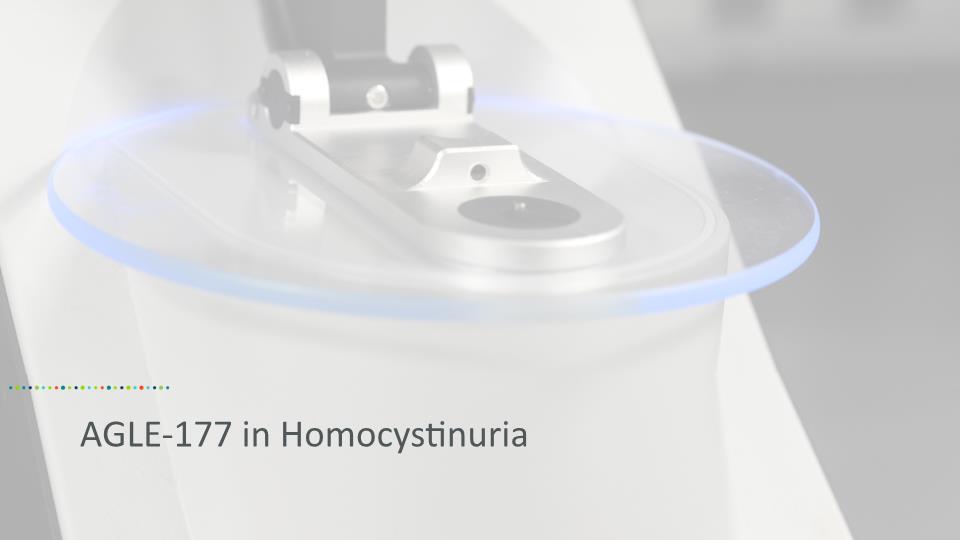
AGLE-177 in Homocystinuria
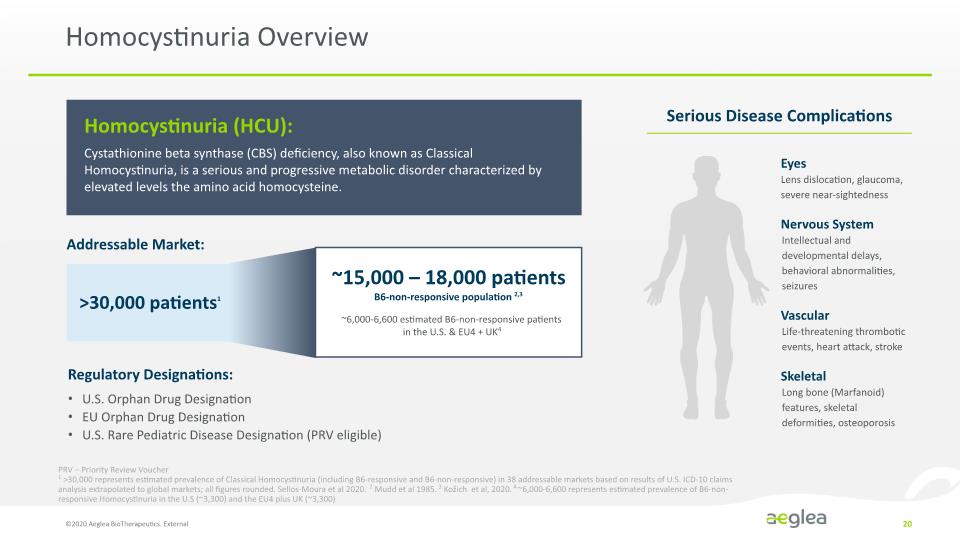
Homocystinuria Overview ©2020 Aeglea BioTherapeutics. External 20 PRV – Priority Review Voucher 1 >30,000 represents estimated prevalence of Classical Homocystinuria (including B6-responsive and B6-non-responsive) in 38 addressable markets based on results of U.S. ICD-10 claims analysis extrapolated to global markets; all figures rounded. Sellos-Moura et al 2020. 2 Mudd et al 1985. 3 Kožich et al, 2020. 4 ~6,000-6,600 represents estimated prevalence of B6-non-responsive Homocystinuria in the U.S (~3,300) and the EU4 plus UK (~3,300) U.S. Orphan Drug Designation EU Orphan Drug Designation U.S. Rare Pediatric Disease Designation (PRV eligible) Regulatory Designations: Homocystinuria (HCU): Cystathionine beta synthase (CBS) deficiency, also known as Classical Homocystinuria, is a serious and progressive metabolic disorder characterized by elevated levels the amino acid homocysteine. Addressable Market: >30,000 patients1 ~15,000 – 18,000 patients B6-non-responsive population 2,3 ~6,000-6,600 estimated B6-non-responsive patients in the U.S. & EU4 + UK4 Serious Disease Complications Eyes Lens dislocation, glaucoma, severe near-sightedness Nervous System Intellectual and developmental delays, behavioral abnormalities, seizures Vascular Life-threatening thrombotic events, heart attack, stroke Skeletal Long bone (Marfanoid) features, skeletal deformities, osteoporosis
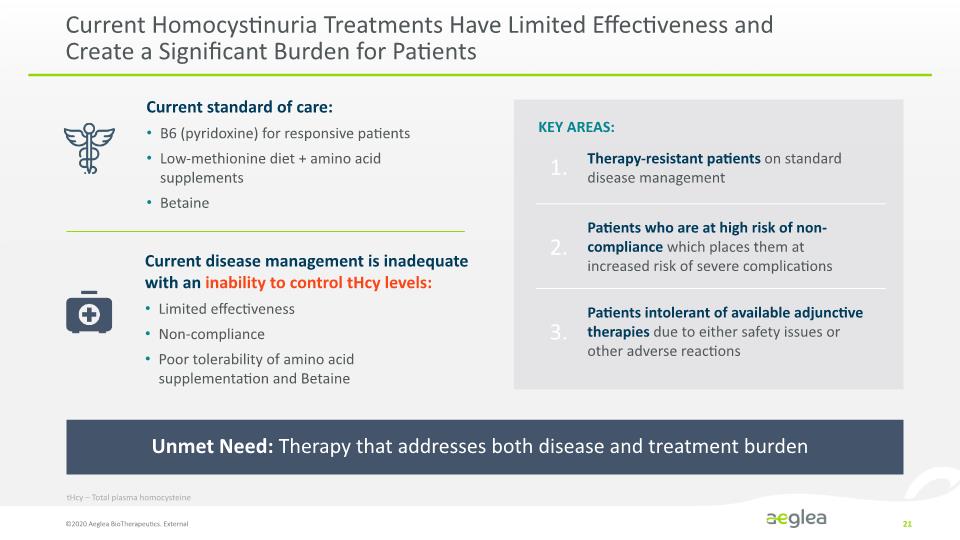
Current Homocystinuria Treatments Have Limited Effectiveness and Create a Significant Burden for Patients ©2020 Aeglea BioTherapeutics. External 21 Patients intolerant of available adjunctive therapies due to either safety issues or other adverse reactions Therapy-resistant patients on standard disease management KEY AREAS: Patients who are at high risk of non-compliance which places them at increased risk of severe complications Unmet Need: Therapy that addresses both disease and treatment burden Current standard of care: B6 (pyridoxine) for responsive patients Low-methionine diet + amino acid supplements Betaine Current disease management is inadequate with an inability to control tHcy levels: Limited effectiveness Non-compliance Poor tolerability of amino acid supplementation and Betaine 1. 2. 3. tHcy – Total plasma homocysteine
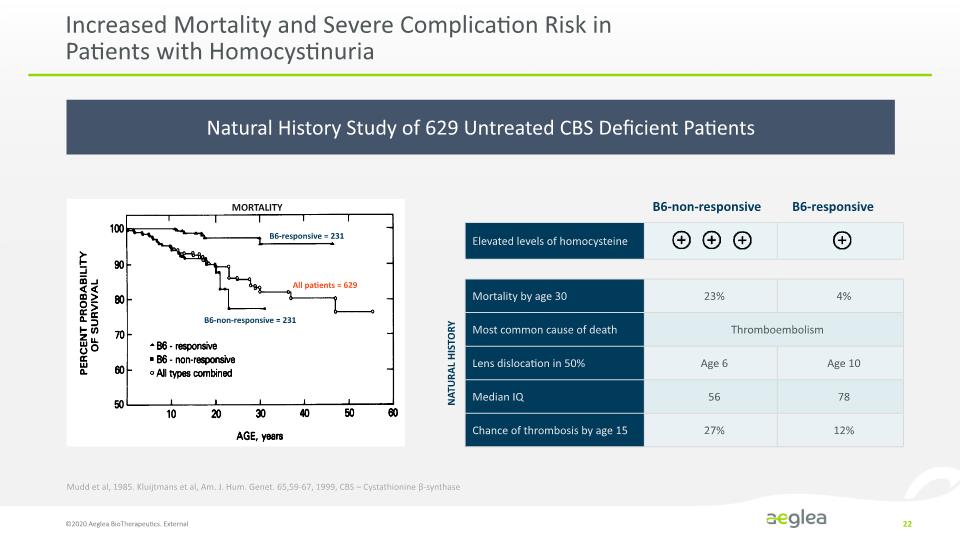
Natural History Study of 629 Untreated CBS Deficient Patients Increased Mortality and Severe Complication Risk in Patients with Homocystinuria ©2020 Aeglea BioTherapeutics. External 22 B6-responsive = 231 All patients = 629 B6-non-responsive = 231 MORTALITY NATURAL HISTORY Mudd et al, 1985. Kluijtmans et al, Am. J. Hum. Genet. 65,59-67, 1999, CBS – Cystathionine β-synthase B6-non-responsive B6-responsive
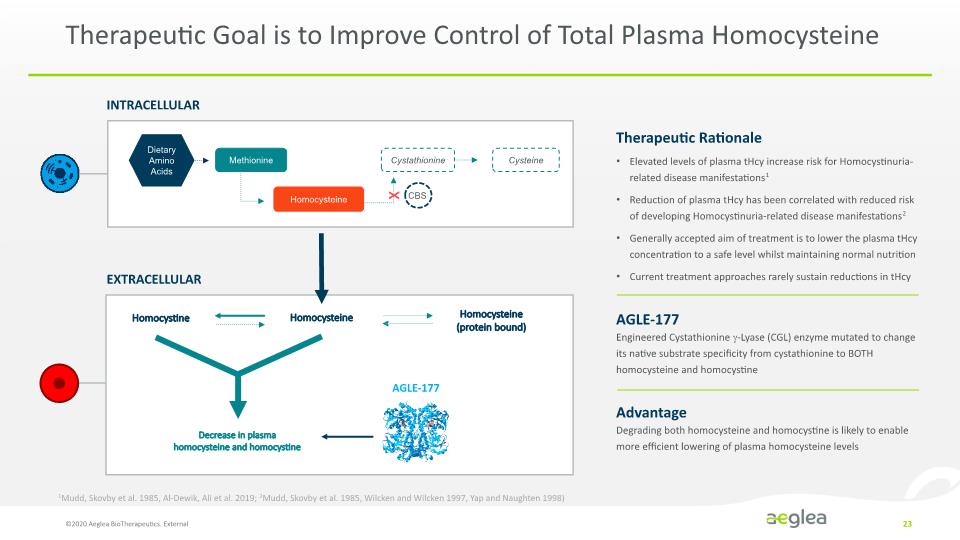
Therapeutic Goal is to Improve Control of Total Plasma Homocysteine ©2020 Aeglea BioTherapeutics. External 23 INTRACELLULAR EXTRACELLULAR Homocysteine Homocystine AGLE-177 Homocysteine (protein bound) Decrease in plasma homocysteine and homocystine X Therapeutic Rationale Elevated levels of plasma tHcy increase risk for Homocystinuria-related disease manifestations1 Reduction of plasma tHcy has been correlated with reduced risk of developing Homocystinuria-related disease manifestations2 Generally accepted aim of treatment is to lower the plasma tHcy concentration to a safe level whilst maintaining normal nutrition Current treatment approaches rarely sustain reductions in tHcy AGLE-177 Engineered Cystathionine -Lyase (CGL) enzyme mutated to change its native substrate specificity from cystathionine to BOTH homocysteine and homocystine Advantage Degrading both homocysteine and homocystine is likely to enable more efficient lowering of plasma homocysteine levels 1Mudd, Skovby et al. 1985, Al-Dewik, Ali et al. 2019; 2Mudd, Skovby et al. 1985, Wilcken and Wilcken 1997, Yap and Naughten 1998)
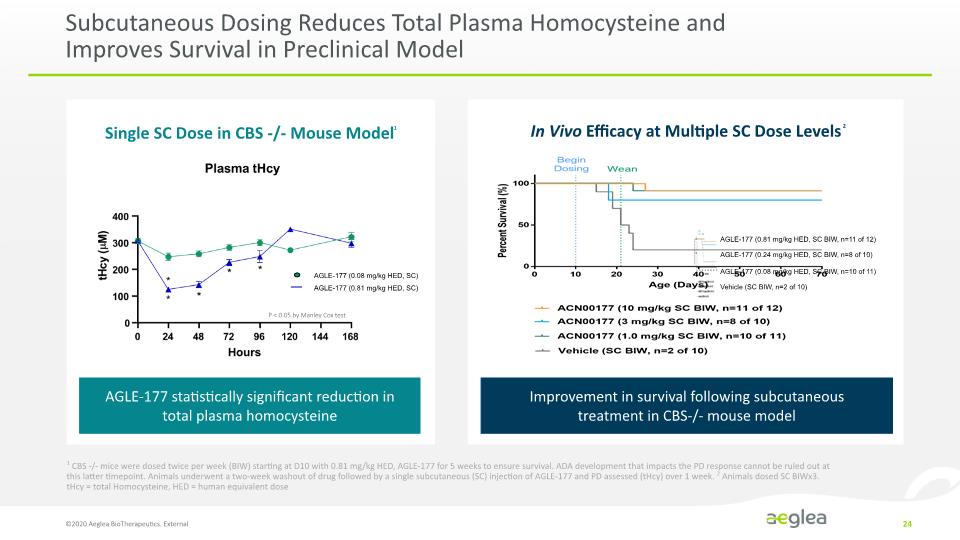
Subcutaneous Dosing Reduces Total Plasma Homocysteine and Improves Survival in Preclinical Model ©2020 Aeglea BioTherapeutics. External 24 P < 0.05 by Manley Cox test AGLE-177 (0.08 mg/kg HED, SC) AGLE-177 (0.81 mg/kg HED, SC) AGLE-177 (0.81 mg/kg HED, SC BIW, n=11 of 12) AGLE-177 (0.24 mg/kg HED, SC BIW, n=8 of 10) AGLE-177 (0.08 mg/kg HED, SC BIW, n=10 of 11) Vehicle (SC BIW, n=2 of 10) Single SC Dose in CBS -/- Mouse Model1 In Vivo Efficacy at Multiple SC Dose Levels2 AGLE-177 statistically significant reduction in total plasma homocysteine Improvement in survival following subcutaneous treatment in CBS-/- mouse model 1 CBS -/- mice were dosed twice per week (BIW) starting at D10 with 0.81 mg/kg HED, AGLE-177 for 5 weeks to ensure survival. ADA development that impacts the PD response cannot be ruled out at this latter timepoint. Animals underwent a two-week washout of drug followed by a single subcutaneous (SC) injection of AGLE-177 and PD assessed (tHcy) over 1 week. 2 Animals dosed SC BIWx3. tHcy = total Homocysteine, HED = human equivalent dose

AGLE-177 Improves Pathologies and Correction of Disease Manifestations in a Preclinical Model of Homocystinuria ©2020 Aeglea BioTherapeutics. External 25 Disease Resolution Disease Reversal Dosing Begins Day 10 CBS-/- Macro-steatosis Disease Progression AGLE-177-HIS 25 mg/kg + Betaine Day 23 CBS-/- AGLE-177-HIS 25 mg/kg Day 60 CBS-/- PBS + Betaine Day 23 CBS-/- Macro-steatosis and necrosis Premature Death Healthy liver from wild-type animal Reversal of Severe Liver Abnormalities in CBS-/- Mouse Model Reductions in total plasma homocysteine leads to improvements in disease related abnormalities Effects on the Long-term Pathologies of Osteoporosis1 Increased BMD in preclinical model of Homocystinuria with multiple doses of AGLE-177 BMD = bone mineral density, HED = human equivalent dose. 1 CBS -/- mice were dosed SC BIW with AGLE-177-HIS starting at D10 through Day 169 were evaluated for bone mineral density (BMD) by dual-energy X-ray absorptiometry
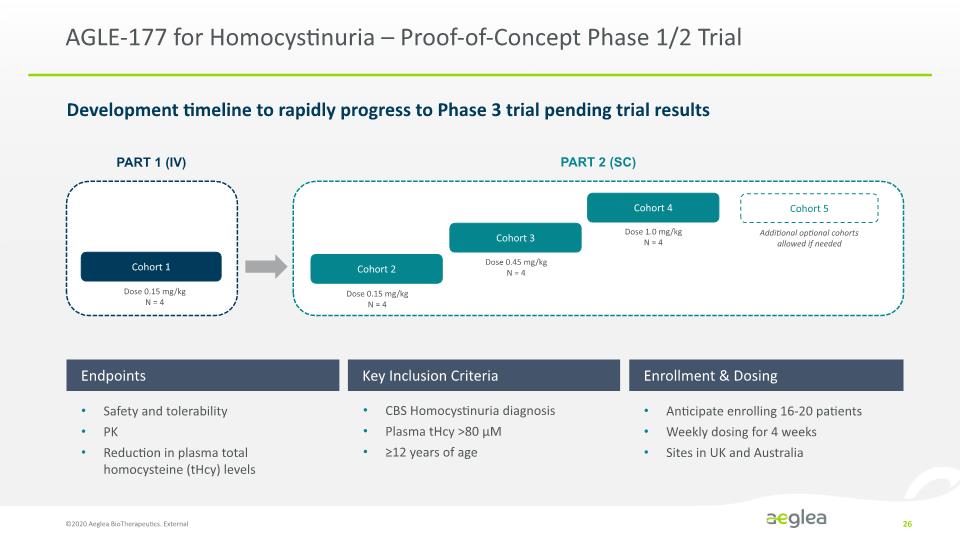
AGLE-177 for Homocystinuria – Proof-of-Concept Phase 1/2 Trial Development timeline to rapidly progress to Phase 3 trial pending trial results ©2020 Aeglea BioTherapeutics. External 26 Endpoints Key Inclusion Criteria Enrollment & Dosing Safety and tolerability PK Reduction in plasma total homocysteine (tHcy) levels CBS Homocystinuria diagnosis Plasma tHcy >80 µM ≥12 years of age Anticipate enrolling 16-20 patients Weekly dosing for 4 weeks Sites in UK and Australia

Homocystinuria ©2020 Aeglea BioTherapeutics. External 27 Limited effectiveness of SOC Limited effectiveness of lowering homocysteine, non-compliance and poor tolerability of low methionine diet and Betaine Natural History study illustrates the toxic build up of homocysteine levels leads to a wide range of life-altering and worsening complications AGLE-177 is an engineered human enzyme designed to address the needs of this patient population which we anticipate will lower the harmful plasma homocysteine levels ~15,000 – 18,000 patients B6-non-responsive population 2,3 ~6,000-6,600 estimated prevalence of B6-non-responsive patients in the U.S. & EU4 + UK4 U.S. Orphan Drug Designation EU Orphan Drug Designation U.S. Rare Pediatric Disease Designation (PRV eligible) PRV – Priority Review Voucher 1 >30,000 represents estimated prevalence of Classical Homocystinuria (including B6-responsive and B6-non-responsive) in 38 addressable markets based on results of U.S. ICD-10 claims analysis extrapolated to global markets; all figures rounded. Sellos-Moura et al 2020. 2 Mudd et al 1985. 3 Kožich et al, 2020. 4 ~6,000-6,600 represents estimated prevalence of B6-non-responsive Homocystinuria in the U.S (~3,300) and the EU4 plus UK (~3,300)
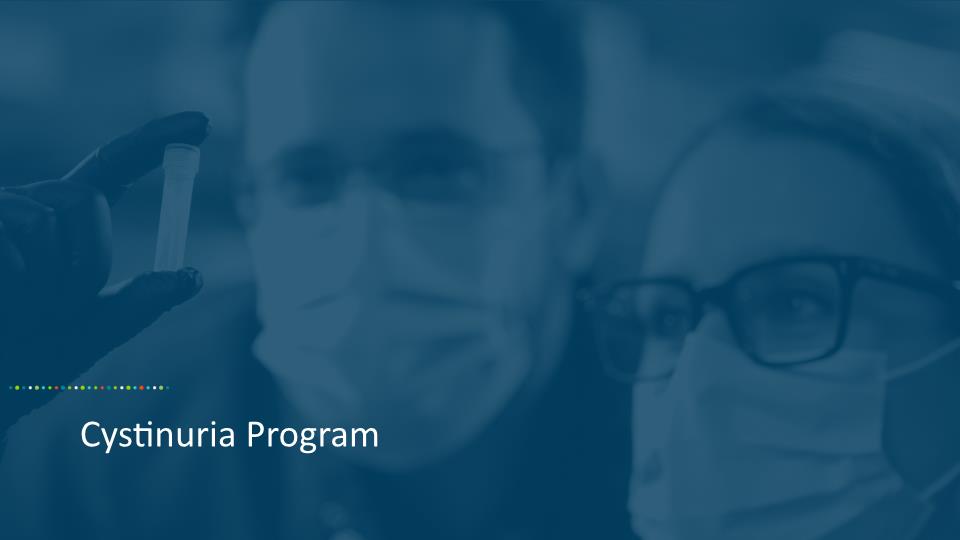
Cystinuria Program

Cystinuria Overview ©2020 Aeglea BioTherapeutics. External 29 Cystinuria: Cystinuria is a metabolic disorder characterized by high levels of amino acid cystine in the urine, leading to the formation of stones in the kidney, ureter and bladder. Persistent stones can result in serious damage to the kidneys, causing an increased risk of hypertension and chronic kidney failure. Addressable Market: Estimated prevalence rate 1:15,000 Based on literature >10,000 Patients in addressable markets Episodes of severe abdominal pain Obstructive syndromes like hydronephrosis Hematuria and infective syndromes like pyelonephritis Chronic pain (opioid addiction risk) Hypertension, chronic kidney disease & reduced life expectancy Cystinuria Impact to Patients Castro Pereira DJ et al 2015, Leslie and Nazzal Renal Calculi (Cystinuria, Cystine Stones) (2018) Reference, Rozanski et al, Mil Med (2005) ), Soucie et al, JM Kidney Int (1994), >10,000 patients in addressable markets represents potential treatable patient population
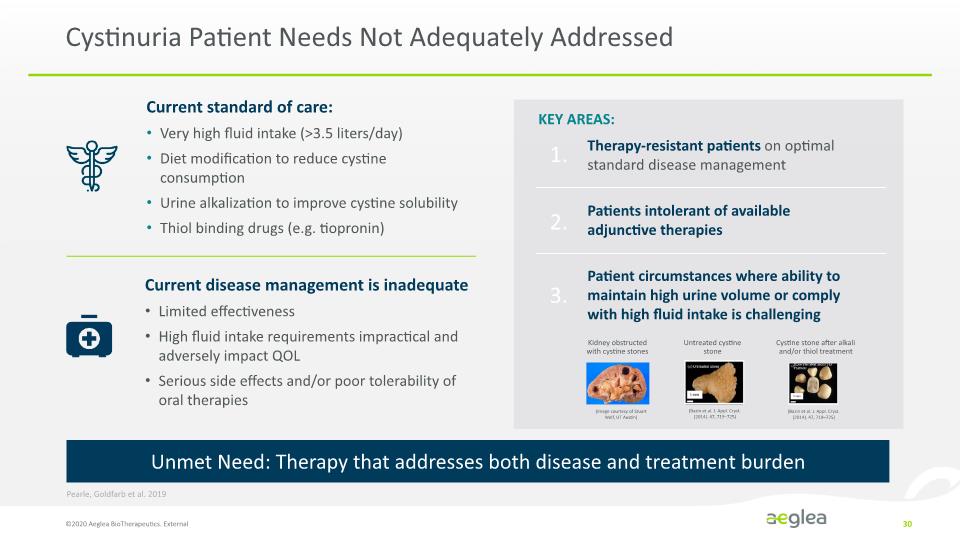
Cystinuria Patient Needs Not Adequately Addressed ©2020 Aeglea BioTherapeutics. External 30 Pearle, Goldfarb et al. 2019 Patient circumstances where ability to maintain high urine volume or comply with high fluid intake is challenging Therapy-resistant patients on optimal standard disease management KEY AREAS: Patients intolerant of available adjunctive therapies 1. 2. 3. Current standard of care: Very high fluid intake (>3.5 liters/day) Diet modification to reduce cystine consumption Urine alkalization to improve cystine solubility Thiol binding drugs (e.g. tiopronin) Current disease management is inadequate Limited effectiveness High fluid intake requirements impractical and adversely impact QOL Serious side effects and/or poor tolerability of oral therapies Unmet Need: Therapy that addresses both disease and treatment burden
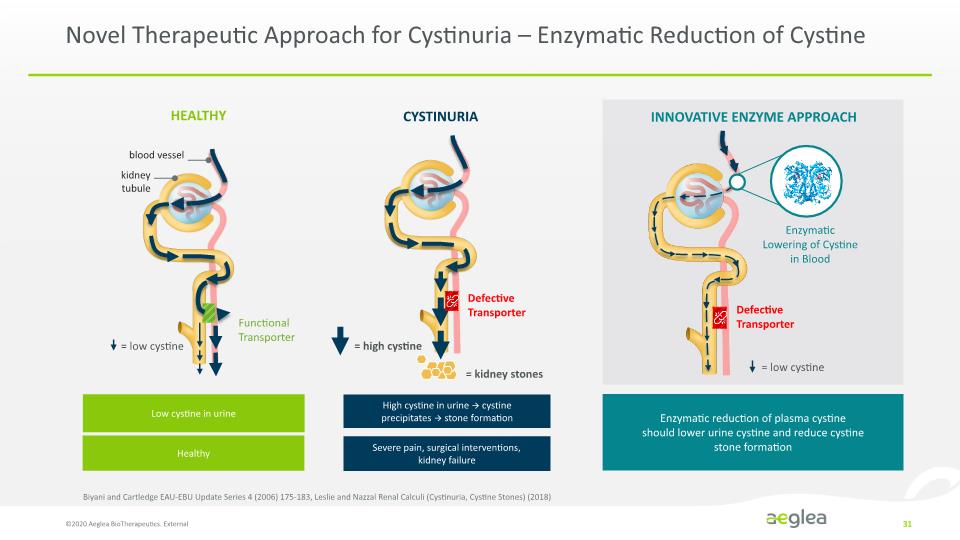
Novel Therapeutic Approach for Cystinuria – Enzymatic Reduction of Cystine ©2020 Aeglea BioTherapeutics. External 31 HEALTHY Low cystine in urine Healthy Functional Transporter INNOVATIVE ENZYME APPROACH Enzymatic reduction of plasma cystine should lower urine cystine and reduce cystine stone formation Biyani and Cartledge EAU-EBU Update Series 4 (2006) 175-183, Leslie and Nazzal Renal Calculi (Cystinuria, Cystine Stones) (2018)

Cystinuria Program: Novel Human Enzyme Solution for Cystinuria ©2020 Aeglea BioTherapeutics. External 32 Before Dosing After Dosing Creating Novel Cystine Degrading Activity1 - Increase catalytic activity - Increase serum stability - Improve manufacturability Slc3a1 -/- mouse urine cystine crystals 1 Cramer SL et al, 2017 Nature Medicine 23:120-7
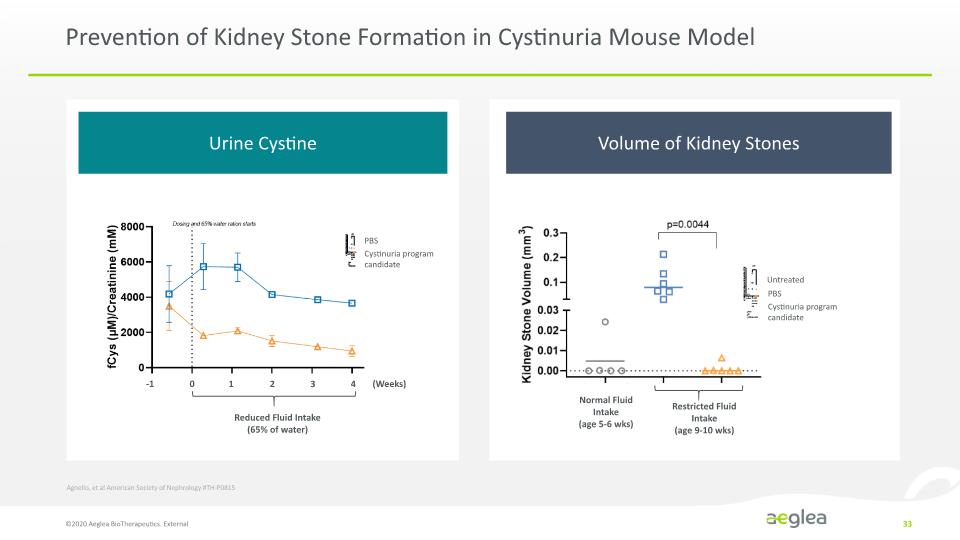
Prevention of Kidney Stone Formation in Cystinuria Mouse Model ©2020 Aeglea BioTherapeutics. External 33 0 1 2 3 4 -1 (Weeks) Reduced Fluid Intake (65% of water) Normal Fluid Intake (age 5-6 wks) Restricted Fluid Intake (age 9-10 wks) Agnello, et al American Society of Nephrology #TH-P0815

Human Enzyme Platform
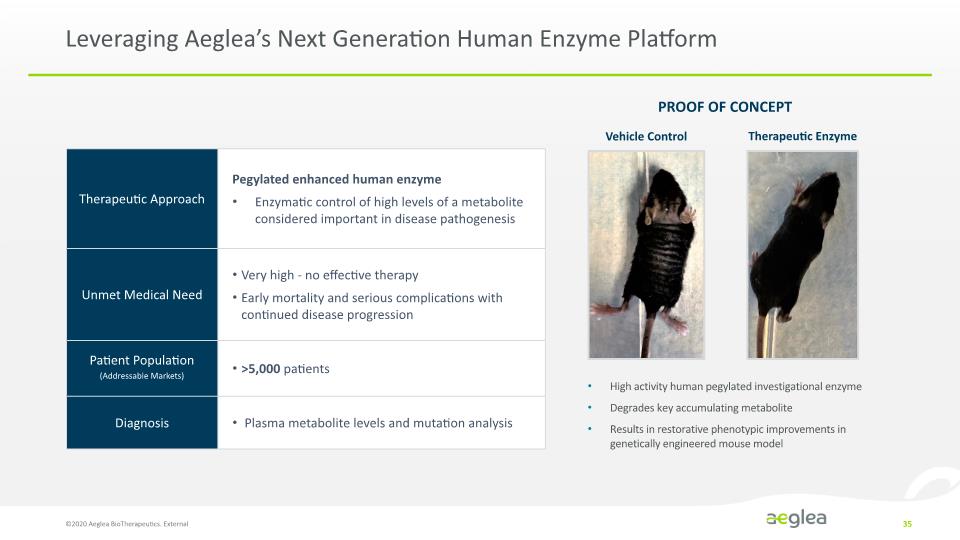
Leveraging Aeglea’s Next Generation Human Enzyme Platform ©2020 Aeglea BioTherapeutics. External 35 High activity human pegylated investigational enzyme Degrades key accumulating metabolite Results in restorative phenotypic improvements in genetically engineered mouse model PROOF OF CONCEPT Vehicle Control Therapeutic Enzyme
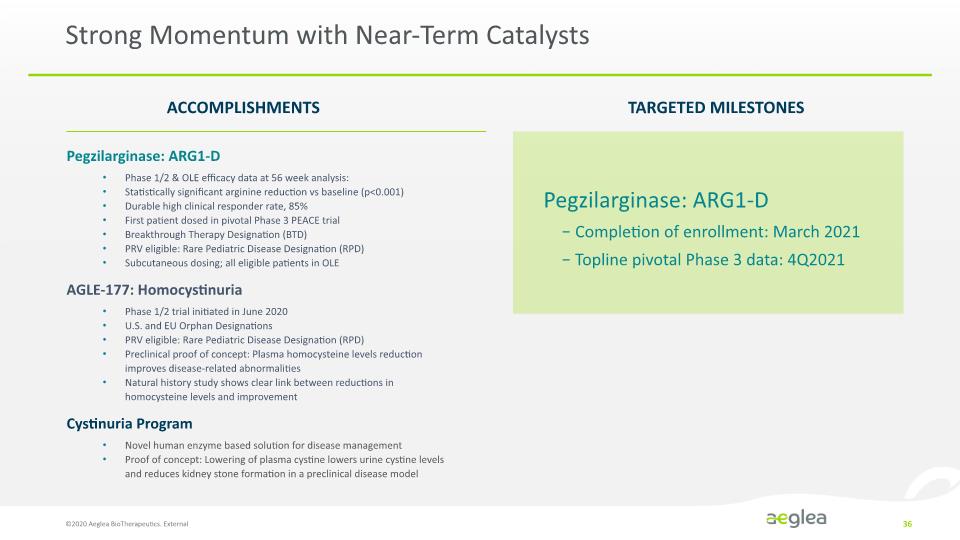
Strong Momentum with Near-Term Catalysts ©2020 Aeglea BioTherapeutics. External 36 ACCOMPLISHMENTS TARGETED MILESTONES Pegzilarginase: ARG1-D Completion of enrollment: March 2021 Topline pivotal Phase 3 data: 4Q2021 Pegzilarginase: ARG1-D Phase 1/2 & OLE efficacy data at 56 week analysis: Statistically significant arginine reduction vs baseline (p<0.001) Durable high clinical responder rate, 85% First patient dosed in pivotal Phase 3 PEACE trial Breakthrough Therapy Designation (BTD) PRV eligible: Rare Pediatric Disease Designation (RPD) Subcutaneous dosing; all eligible patients in OLE AGLE-177: Homocystinuria Phase 1/2 trial initiated in June 2020 U.S. and EU Orphan Designations PRV eligible: Rare Pediatric Disease Designation (RPD) Preclinical proof of concept: Plasma homocysteine levels reduction improves disease-related abnormalities Natural history study shows clear link between reductions in homocysteine levels and improvement Cystinuria Program Novel human enzyme based solution for disease management Proof of concept: Lowering of plasma cystine lowers urine cystine levels and reduces kidney stone formation in a preclinical disease model
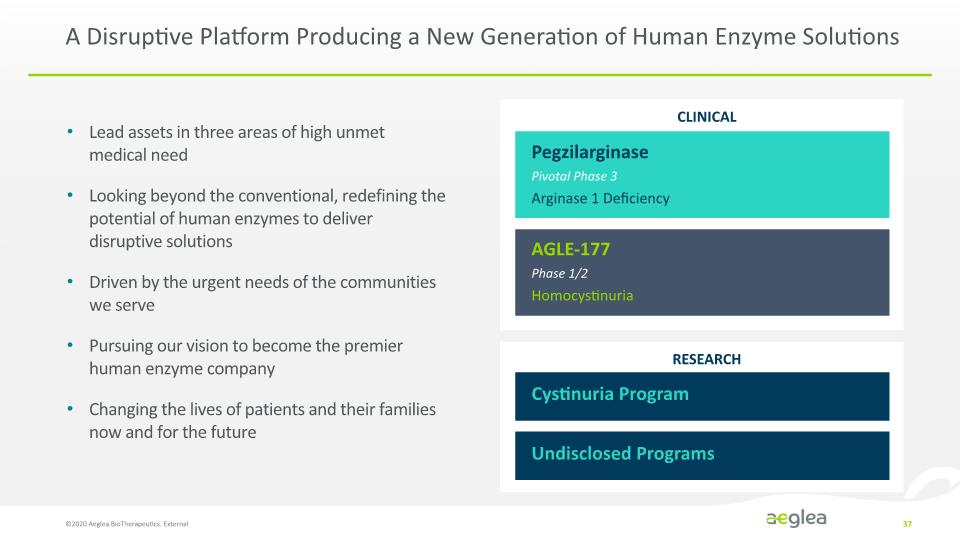
A Disruptive Platform Producing a New Generation of Human Enzyme Solutions ©2020 Aeglea BioTherapeutics. External 37 Lead assets in three areas of high unmet medical need Looking beyond the conventional, redefining the potential of human enzymes to deliver disruptive solutions Driven by the urgent needs of the communities we serve Pursuing our vision to become the premier human enzyme company Changing the lives of patients and their families now and for the future CLINICAL RESEARCH Pegzilarginase Pivotal Phase 3 Arginase 1 Deficiency AGLE-177 Phase 1/2 Homocystinuria Cystinuria Program Undisclosed Programs

Financial Summary ©2020 Aeglea BioTherapeutics. External 38 “Non-GAAP” cash, cash equivalents and marketable securities as of September 30, 2020: $166.1 million1 (no debt) As of November 2, 2020, 65.5 million2 common shares and pre-funded warrants outstanding Expected funding runway: into 2023 WE OWN WORLDWIDE COMMERCIAL RIGHTS TO OUR PIPELINE 1Includes $24.6M net proceeds from shares of common stock sold under our ATM program between October 1, 2020 and November 4, 2020 along with cash, cash equivalents, restricted cash and marketable securities of $141.5M as of September 30, 2020. This amount reflects Aeglea’s estimates based solely upon information available to it as of the date of the quarterly report, and the amount reported is not a comprehensive statement of its financial results or position as of September 30, 2020. Includes $1.5mm of restricted cash. 2Includes 47.9 million common shares outstanding and 17.6 million pre-funded warrants
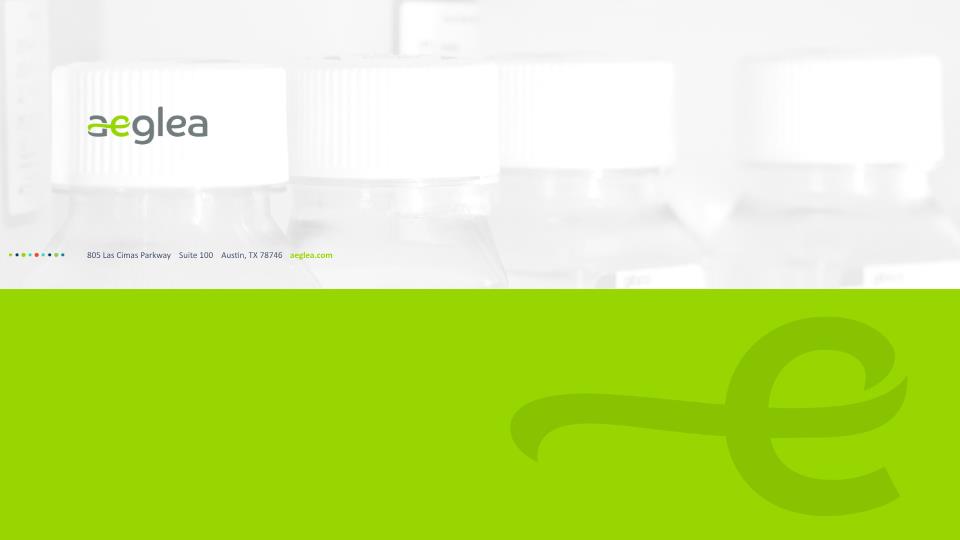
805 Las Cimas Parkway Suite 100 Austin, TX 78746 aeglea.com
